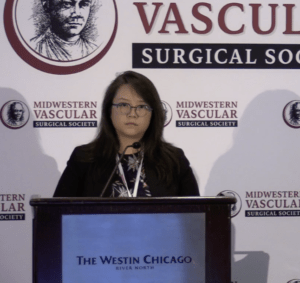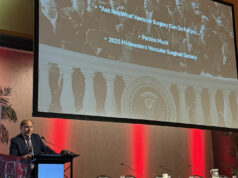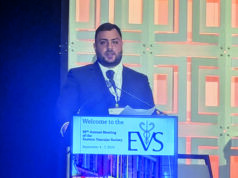
Outcomes in a cohort of patients who consented to one year of follow-up after transcarotid revascularization (TCAR) treatment for carotid stenosis in the ROADSTER 2 trial showed a 97.4% rate of technical success, no incidences of ipsilateral stroke and a 2.6% mortality rate, the 2021 annual meeting of the Midwestern Vascular Surgical Society (Sept. 9–11) heard.
The prospective, open-label, single-arm, multi-registry study included 155 per protocol participants from 21 U.S. centers and one in Europe followed between June 2016 and November 2018 who were evaluated 365 days postoperatively.
The results were presented by Kristine L. So, MD, a vascular surgery fellow at University Hospitals Cleveland Medical Center in Cleveland, Ohio, with the research team concluding that “in patients with high-risk factors, TCAR yields high technical success with an extraordinarily low stroke and death rate at one year. Further comparative studies to CEA [carotid endarterectomy] are warranted.” Senior author on the one-year outcomes study was Vikram Kashyap, MD, chief of the division of vascular surgery and endovascular therapy and the co-director of the Vascular Center of the Harrington Heart & Vascular Institute at University Hospitals Cleveland Medical Center.
The early outcomes section of the ROADSTER 2 study reporting the perioperative outcomes of TCAR up to 30 days were promising, So explained. “Over the course of approximately four years, the technical success reached 99.7%, with the stroke rate, death rate and perioperative MI [myocardial infarction] rate all less than 1%. A composite 30-day stroke, death and MI rate was also only 1.7%.”
In the one-year follow-up cohort, So and colleagues found that the patient population included a similar breakdown to the early outcomes group: those with asymptomatic disease numbered 119 (76.8%), and symptomatic patients represented 36 (23.2%).
They presented with a variety of high-risk anatomic (43.2%), physiologic (31.6%), or combined actors (25.2%). No patient suffered perioperative MI or stroke. There were four deaths (2.6%) and no ipsilateral strokes. Of the deaths, three occurred in asymptomatic patients, with one symptomatic. All deaths were from non-neurological causes. These findings were comparable to early outcomes in the 30-day cohort, the researchers noted.
So acknowledged limitations in the study, including the fact there were only 155 patients from the original 632 in ROADSTER 2 who remained in the long-term follow-up study. “Additionally, the follow-up period did not start until about a year and half following the initiation of the ROADSTER 2 trial,” she added.
“Of the 11 subjects who had initially consented to the long-term follow-up who had been excluded for per protocol deviations—within that, one did suffer from an ipsilateral stroke. That patient was ultimately excluded. These limitations emphasize the need for larger observational and comparative studies.”
So said the research team’s long-term follow-up analysis of the ROADSTER 2 cohort “provides evidence that TCAR is performed with low rates of mortality and ipsilateral stroke. This minimally invasive technique can [be] and is used safely in high-risk patients with extracranial carotid disease. There is, however, still a need for larger comparative controlled trials to confirm the safety and efficacy of TCAR.”
The ROADSTER 2 post-approval study was launched to evaluate real-world usage of TCAR—the Enroute transcarotid stent when used with the Enroute transcarotid neuroprotection system—in patients with significant carotid disease by physicians of varying experience with the transcarotid technique.












